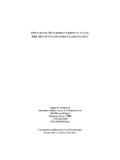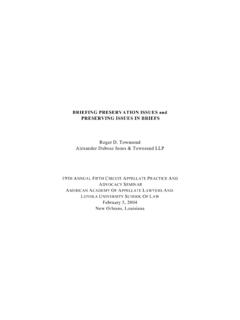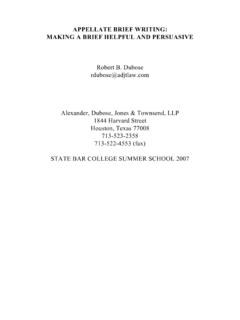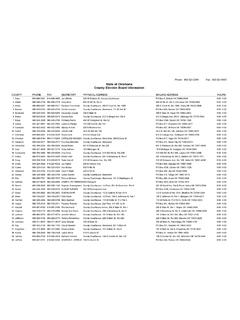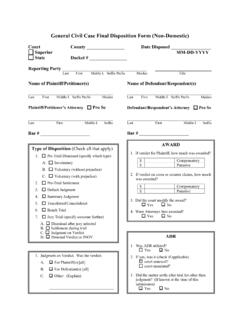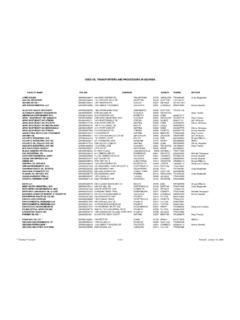Transcription of PETITION PRACTICE BEFORE THE SUPREME …
1 PETITION PRACTICE BEFORE THE SUPREME court OF TEXAS DOUGLAS W. ALEXANDER ALEXANDER DUBOSE & TOWNSEND LLP 515 Congress Ave., Suite 2350 Austin, Texas 78701 (Telephone) (512) 482-9301 (Facsimile) (512) 482-9303 LORI MASON COOLEY GODWARD LLP Five Palo Alto Square 3000 El Camino Real Palo Alto, California 94306 (Telephone) 650-843-5000 (Facsimile) 650-857-0663 Jefferson County Bar Association Appellate CLE April 1, 2011 Beaumont, Texas 2011 DOUGLAS W. ALEXANDER AND LORI ELLIS PLOEGER PETITION PRACTICE BEFORE the SUPREME court of Texas i About the Authors Douglas W. Alexander is a founding partner in the Austin office of Alexander Dubose & Townsend LLP. Doug has a statewide appellate PRACTICE with particular expertise BEFORE the SUPREME court of Texas.
2 He also has an active amicus PRACTICE BEFORE that court . Doug is a former Chair of the Appellate Section of the State Bar of Texas. He has also served as an Adjunct Professor of Appellate Advocacy at the University of Texas School of Law, a member of the Civil Appellate Law Examination Commission of the Texas Board of Legal Specialization, and a law clerk to the Honorable John R. Brown, former Chief Judge of the United States court of Appeals for the Fifth Circuit. Doug is a Fellow of the American Academy of Appellate Lawyers and is board certified in Civil Appellate Law by the Texas Board of Legal Specialization. Lori Mason is a partner with the California-based firm of Cooley Godward LLP, where her PRACTICE centers on appellate litigation.
3 She received her , with highest honors, from the University of Texas. She received her , with high honors, from the University of Texas School of Law, where she was Executive Editor of the Texas Law Review, earned membership in the Order of the Coif, and was named Keeper of the Peregrinus for the Chancellors Honor Society. Lori served as a briefing attorney to the Honorable Priscilla R. Owen of the SUPREME court of Texas and as a law clerk to the Honorable Fortunato P. Benavides of the United States court of Appeals for the Fifth Circuit. PETITION PRACTICE BEFORE the SUPREME court of Texas ii TABLE OF CONTENTS Page I. INTERNAL PROCEDURES .. 1 A. Routing of Petitions .. 1 1. Petitions for Review.
4 1 2. Mandamus Petitions .. 2 B. Action on Petitions Conveyor Belt System .. 2 C. Pink, Purple, and Yellow Vote Sheets.. 3 1. Pink Vote Sheet .. 3 2. Purple Vote Sheet .. 3 3. Yellow Vote Sheet .. 4 D. Study Memo Procedure and Request for full Briefing on the Merits .. 4 E. Votes Required for Specific Actions .. 5 F. Odds of the court Taking Specific Actions .. 5 G. CaseMail .. 5 II. GOAL OF THE PETITION .. 6 A. Demonstrating Substantial Importance .. 6 B. Grabbing the court s Attention the Hook .. 6 III. BREVITY IS THE SOUL OF AN EFFECTIVE PETITION .. 7 I V. BASIC REQUIREMENTS .. 7 A. Formatting .. 7 1. Margins .. 7 2. Spacing .. 7 3. Font .. 8 4. Record 8 5. Footnotes .. 8 6. Page Limitations .. 8 B. Filing .. 8 1. Location .. 8 2.
5 Copies .. 9 a. Hardcopies .. 9 b. Electronic copies .. 9 3. Fees .. 9 C. Deadlines .. 9 D. Motions to Extend Time ( METs ) .. 10 E. Amendment .. 11 V. ANATOMY OF PETITION .. 11 A. Cover of PETITION .. 11 B. Preliminary Sections .. 12 1. Identity of Parties and Counsel .. 12 2. Table of Contents .. 13 3. Index of Authorities .. 13 4. Statement of the Case .. 13 5. Statement of Jurisdiction .. 15 6. Issues Presented .. 17 a. Limiting Briefed Issues .. 17 b. Preserving Unbriefed Issues in the PETITION for Review .. 18 c. Listing Issues .. 18 d. Framing Issues .. 18 (i) Frame to Demonstrate Importance .. 18 (ii) Frame Neutrally .. 18 (iii) Frame for Disposition Sought .. 19 PETITION PRACTICE BEFORE the SUPREME court of Texas iii e. Split of Opinion on Single Versus Multi-Sentence Issues.
6 19 C. Body of PETITION .. 21 1. Salutation .. 21 2. Grabber .. 21 3. Statement of Facts .. 21 4. Summary of the Argument .. 22 5. Argument .. 22 a. Reasons why SUPREME court Should Exercise Jurisdiction .. 23 b. Argument on the Merits .. 25 6. Prayer .. 25 7. Signature .. 26 8. Certificate of 26 9. Appendix .. 26 VI. RESPONSE TO PETITION .. 28 A. Whether to File a Response .. 28 1. Respond if the petitioner failed to preserve error and waived the legal issue being asserted.. 28 2. Respond if the correct standard of review does not permit the result that the petitioner advocates.. 29 3. Respond if though the courts below may have erred, the error is harmless (or, in mandamus PRACTICE , the petitioner has an adequate remedy by appeal).. 29 4. Respond if stare decisis compels affirmance of the court of appeals decision or denial of mandamus.
7 29 5. Respond if there is an independent ground for affirmance that petitioner failed to address.. 29 B. When to file a Waiver of Response to PETITION for Review .. 30 C. How to Respond .. 30 1. Additional arguments to dissuade the court from granting review.. 30 a. The case is fact-intensive and is important only to the parties to the appeal.. 30 b. The purported conflict among appellate courts is illusory.. 31 c. Even if the issue is one of first impression in Texas, it should be allowed to percolate through the intermediate appellate courts.. 31 d. The issue of jurisprudential importance cannot cleanly be reviewed by the court .. 31 e. The court of appeals correctly resolved the legal issue and there is no sound reason to disturb its decision.. 31 2.
8 Developing a persuasive response .. 31 a. Table of Contents .. 32 b. Statement of the Case .. 32 c. Statement of Jurisdiction .. 32 d. Issues Presented .. 32 (i) Dissatisfaction with the Statement of Issues in the Petitioner s Brief .. 33 (ii) Asserting independent grounds for affirmance .. 33 (iii) Entitlement to judgment less favorable than that rendered by the court of appeals but more favorable than that sought by petitioner .. 33 e. Introduction to Body of PETITION .. 33 f. Statement of Facts .. 33 g. Summary of the Argument .. 34 h. Argument .. 34 i. Prayer .. 34 j. Appendix .. 34 D. Filing a Cross- PETITION As Well As a Response .. 34 PETITION PRACTICE BEFORE the SUPREME court of Texas iv VII. REPLY TO THE RESPONSE .. 35 VIII. BRIEFS ON THE MERITS.
9 35 A. Internal Procedures and Deadlines .. 35 B. To File or Not to File .. 36 1. Unbriefed 36 2. Authorities from Other Jurisdictions, Treatises, and Public Policy Issues .. 36 C. Supplement to PETITION or Stand-Alone Document .. 37 D. Differences (besides length) Between PETITION and Brief on the Merits .. 37 1. Issues Presented .. 37 2. Argument .. 37 3. Appendix .. 38 E. Response Brief .. 38 F. Reply Brief .. 38 IX. SUBMISSION AND ARGUMENT .. 38 A. Submission without Oral Argument .. 38 B. Submission with Argument .. 38 C. Time for Argument .. 39 D. Number of Counsel .. 39 E. Argument by Amicus Curiae .. 39 F. Purpose of Argument .. 39 G. Oral Argument Exhibits .. 39 1. Charts .. 39 2. Handouts .. 40 X. MOTION FOR 40 A. Motions for Rehearing Generally.
10 40 1. Internal Procedures .. 40 2. Deadline .. 40 3. Extensions of Time .. 41 B. Page Limitations .. 41 C. No Successive Motions .. 41 D. Motion for Rehearing on Denial of PETITION .. 41 1. Whether To File .. 41 2. Strategy .. 41 E. Motion for Rehearing of Cause .. 42 F. Response .. 43 XI. CONCLUSION .. 43 BIBLIOGRAPHY .. 44 APPENDIX 1 .. Flowchart APPENDIX 2 .. Vote Sheet APPENDIX 3 .. Sample PETITION APPENDIX 4 .. Waiver Letter PETITION PRACTICE BEFORE the SUPREME court of Texas v Acknowledgments The authors wish to thank Justice Nathan L. Hecht, former Chief Justice Thomas Phillips, and former Justices Craig T. Enoch, Priscilla R. Owen, James A. Baker, Deborah Hankinson, John Cornyn, Rose Spector, Greg Abbott, and Raul A. Gonzalez along with present and former court staff members, including Andrew Weber, former Clerk of the court ; Christopher A.

